Kroger stock falls after Amazon announces major grocery expansion
Ford Motor Company (NYSE:F) reported a significant decline in financial performance for the first quarter of 2025, with revenue falling 5% year-over-year to $40.7 billion and adjusted EBIT plummeting 63% to $1.0 billion. The company cited tariff impacts and planned production downtime as key factors behind the results, leading to the suspension of its full-year guidance due to ongoing tariff-related uncertainties.
Executive Summary
Ford’s Q1 2025 results revealed substantial challenges across most business segments, with adjusted EBIT margin dropping to 2.5%, down 4.0 percentage points year-over-year. The company reported adjusted free cash flow of negative $1.5 billion, a decline of $1.0 billion from the previous year. Despite these headwinds, Ford maintained its quarterly dividend of $0.15 per share and highlighted its strong liquidity position with $27 billion in cash and $45 billion in total liquidity.
As shown in the following comprehensive financial summary chart from Ford’s presentation:
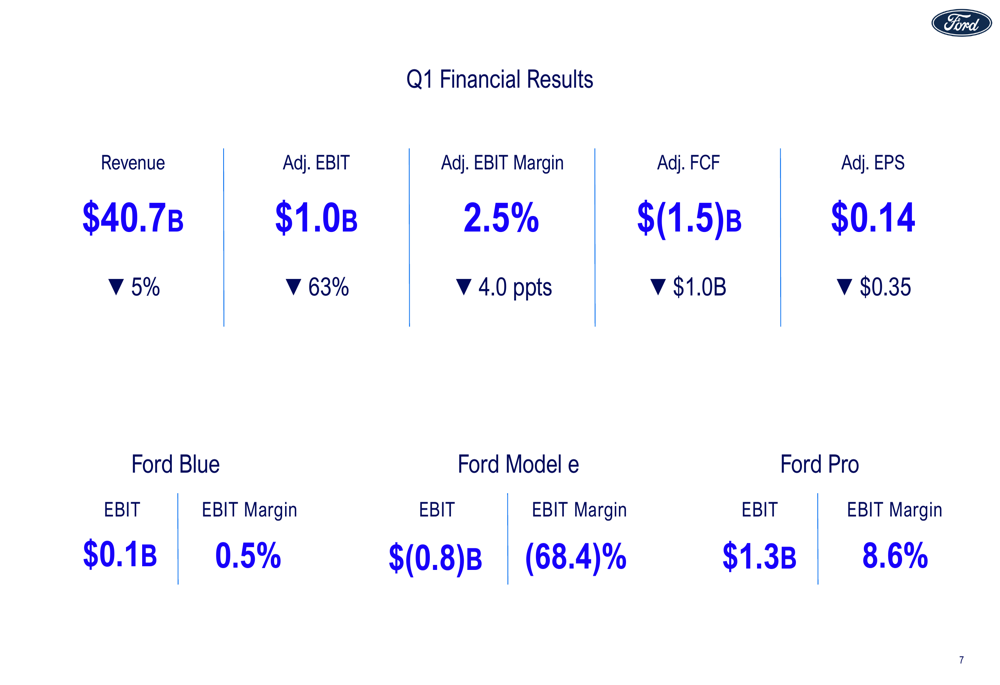
Ford’s business segments showed mixed performance, with Ford Pro delivering solid results while Ford Blue barely broke even and Ford Model e continued to generate significant losses. The company noted that Q1 EBIT was adversely impacted by nearly $200 million in added tariff costs, offsetting gains from cost reduction initiatives.
Segment Performance Analysis
Ford’s business is structured around three distinct customer-focused segments, each with different performance trajectories in Q1:
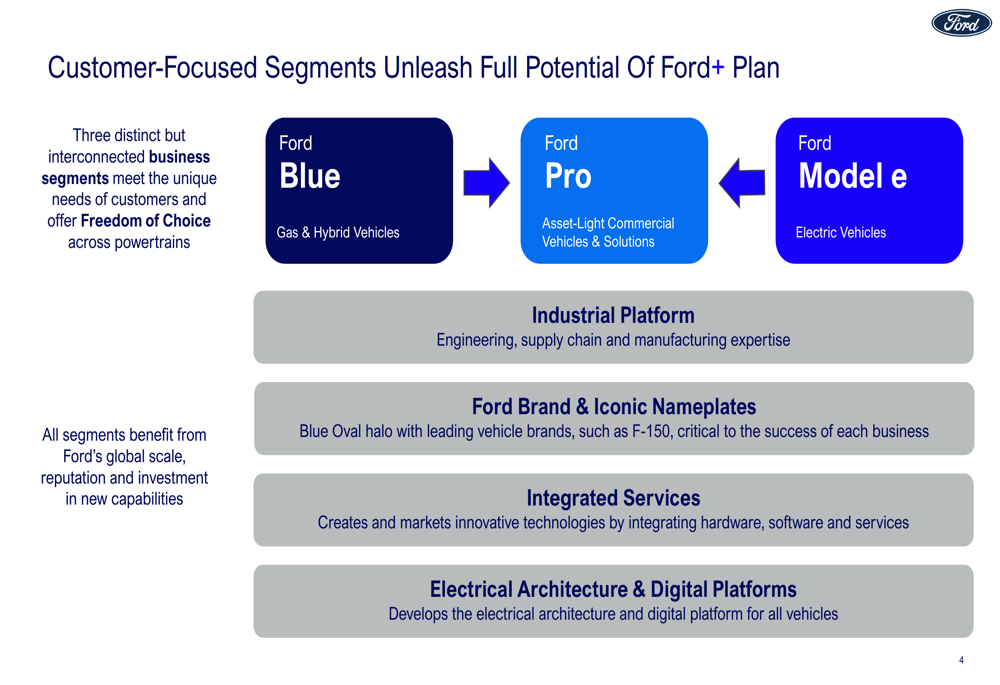
Ford Pro emerged as the standout performer, generating $1.3 billion in EBIT with an 8.6% margin. This commercial vehicles and services division continues to be the company’s most reliable profit generator, though its performance was down from previous quarters.
Ford Blue, the traditional internal combustion engine business, barely broke even with just $0.1 billion in EBIT and a razor-thin 0.5% margin. The company attributed this to planned production downtime, targeted inventory reductions, and tariff impacts.
Ford Model e, the electric vehicle division, remained deeply unprofitable with an $0.8 billion EBIT loss and a negative margin of 68.4%. However, the company noted that U.S. electrified vehicle sales increased by 26% year-over-year, suggesting some positive momentum in this segment despite the financial losses.
The following segment performance breakdown provides additional detail on each division’s contribution:
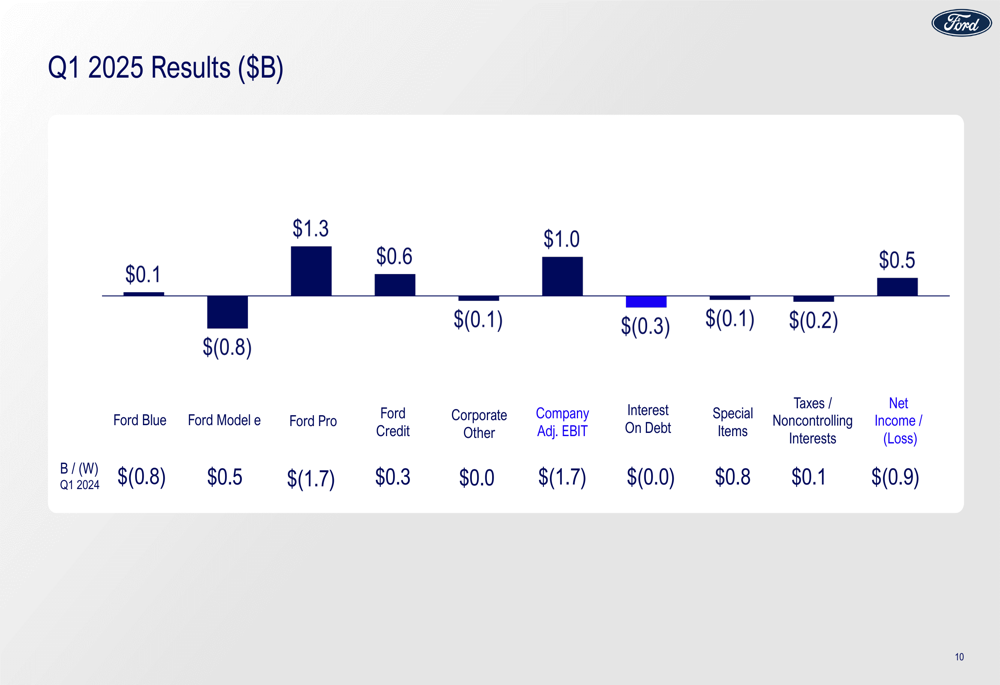
Financial Position and Cash Flow
Ford’s cash position deteriorated in Q1 2025, with adjusted free cash flow turning negative at $(1.5) billion compared to positive results in previous quarters. The company’s cash balance declined to $45.3 billion from $46.7 billion in the previous quarter, while cash net of debt fell to $7.0 billion from $8.7 billion.
The following chart illustrates Ford’s cash flow, cash balance, and liquidity trends over the past five quarters:
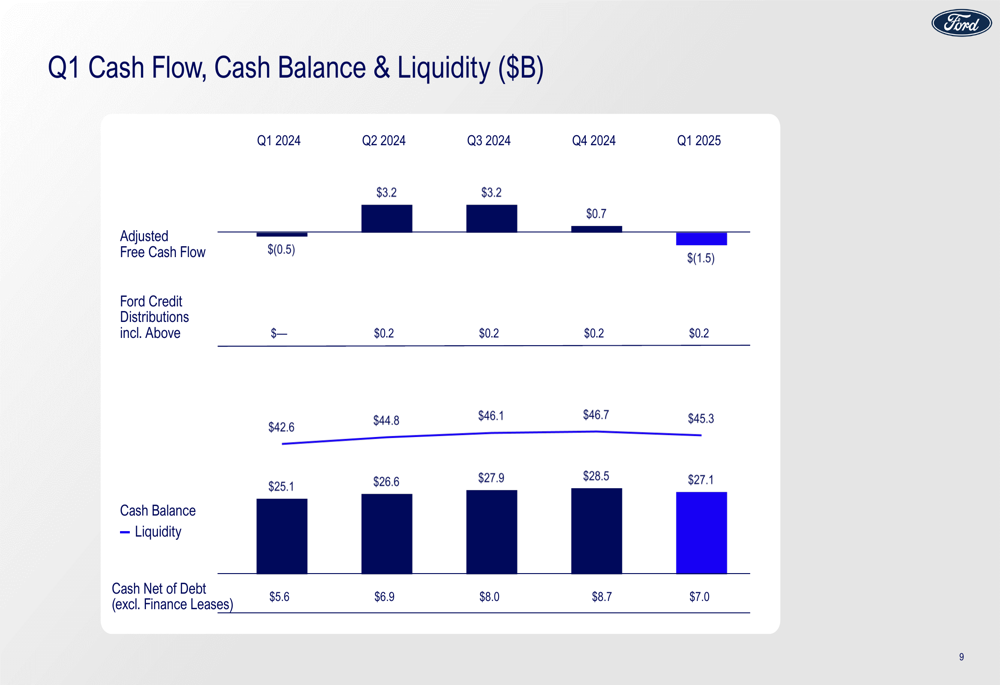
Despite the negative cash flow, Ford maintained its financial strength with substantial liquidity. The company also highlighted its renewed $18 billion corporate credit facilities, providing additional financial flexibility.
A more detailed view of Ford’s cash flow and balance sheet is presented in this comprehensive table:
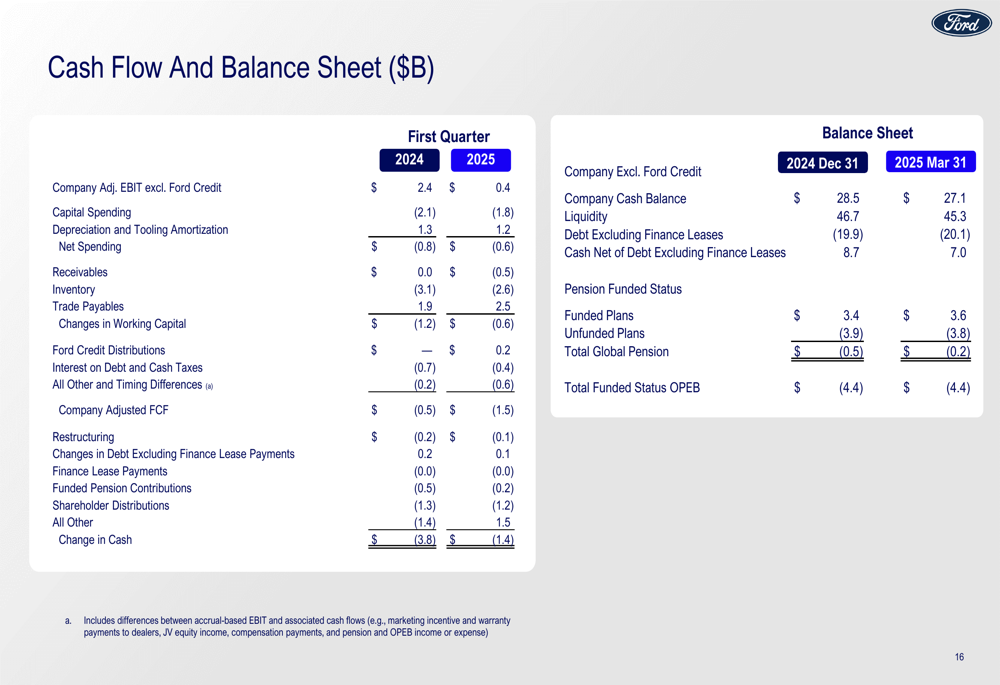
Tariff Impact and Guidance Suspension
Perhaps the most significant development in Ford’s Q1 presentation was the suspension of full-year guidance due to tariff-related uncertainties. The company stated that its underlying business remains strong and is tracking within its previous full-year adjusted EBIT guidance range of $7 billion to $8.5 billion, excluding tariff impacts.
However, Ford estimates the full-year gross cost of tariffs at approximately $2.5 billion, with a net adjusted EBIT impact of approximately $(1.5) billion. Given these material tariff-related near-term risks and the potential range of outcomes, management decided to suspend all full-year guidance.
The following slide outlines Ford’s guidance position:
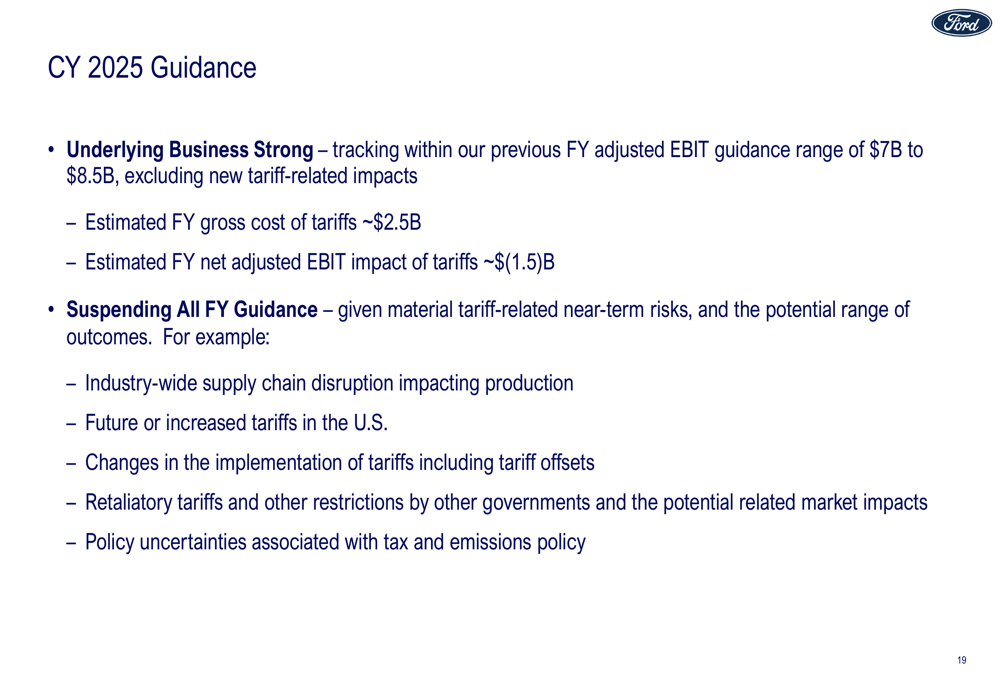
Strategic Positioning and Market Context
Despite the financial challenges, Ford continues to position itself as "America’s #1 Auto Manufacturer" with significant investments in U.S. production and a strong domestic supply chain. The company highlighted its $50 billion investment in U.S. vehicle production since 2020 and $35 billion spending on its U.S. supplier base in 2024.
Ford emphasized its "freedom of choice" global product portfolio spanning internal combustion engines, hybrids, and electric vehicles. The company noted it remains America’s #1 seller of total pickups, with its best sales start since 2004, and achieved year-over-year cost reductions for the third consecutive quarter, excluding tariff impacts.
The company’s quarterly highlights and strategic positioning are summarized in this slide:
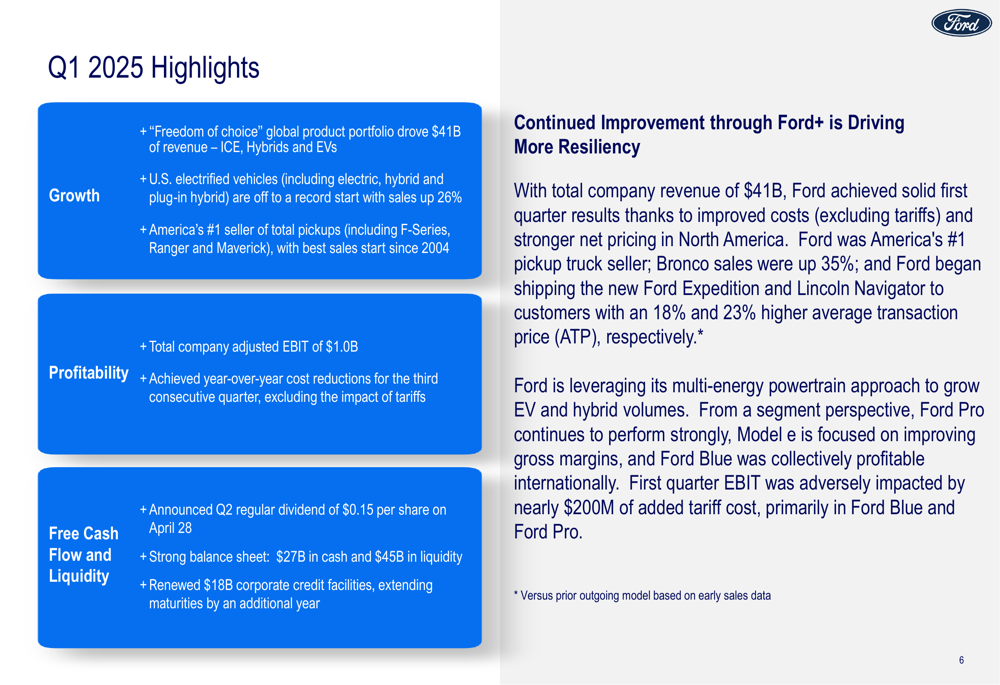
EBIT Performance Drivers
To better understand the factors driving Ford’s year-over-year EBIT decline, the company provided a detailed bridge analysis. The primary negative factors included volume/mix effects, exchange rates, and costs (particularly tariffs), partially offset by positive net pricing.
The following EBIT bridge illustrates these dynamics:

Forward Outlook
While Ford suspended its formal full-year guidance, the company’s presentation suggests several key trends to watch:
1. Continued strong performance from Ford Pro, though with potential pricing pressures
2. Ongoing losses in the Ford Model e segment, albeit with growing sales of electrified vehicles
3. Significant tariff headwinds expected to persist throughout 2025
4. Focus on cost reduction initiatives to offset external pressures
5. Maintaining financial flexibility with strong cash and liquidity positions
The company’s Q1 results represent a significant departure from its performance in the previous quarter. In Q3 2024, Ford reported 5% revenue growth to over $46 billion and adjusted EBIT of $2.6 billion with a 5.5% margin. The contrast highlights the impact of tariffs and production adjustments on the company’s financial trajectory.
As Ford navigates these challenges, investors will be closely watching whether the company can maintain its dividend, improve profitability in its Ford Blue and Model e segments, and effectively mitigate the impact of tariffs on its overall business performance.
Full presentation:
This article was generated with the support of AI and reviewed by an editor. For more information see our T&C.
